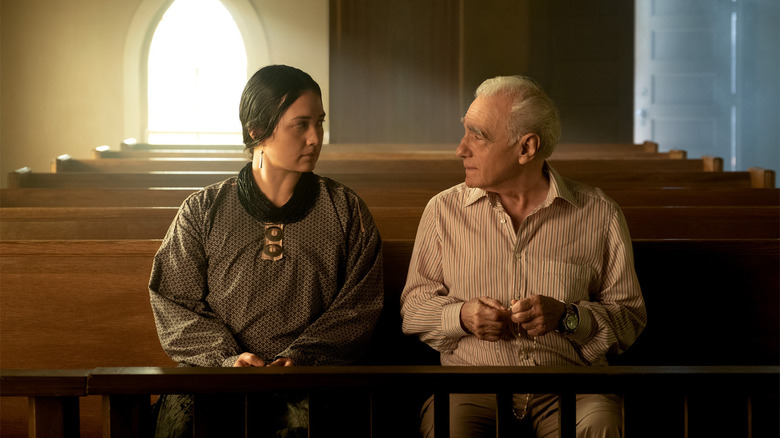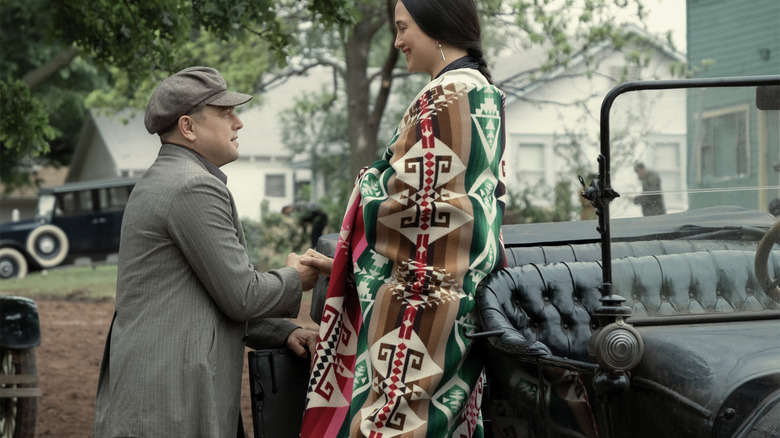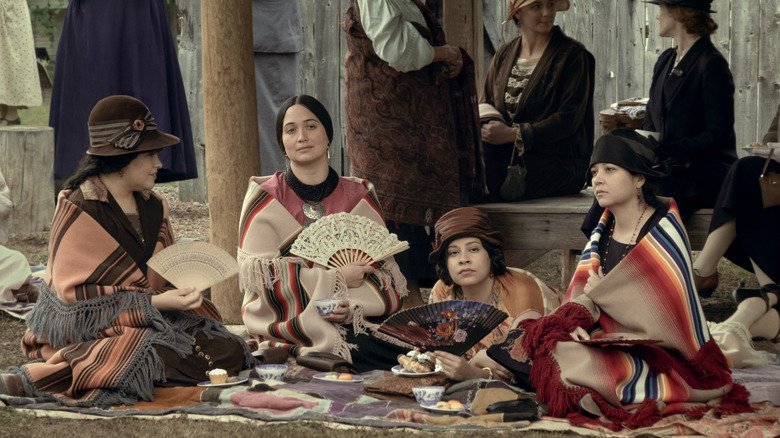Killers Of The Flower Moon's Quest For Osage Authenticity Reinvigorated Forgotten Traditions
It seems more and more like audiences, critics, and creatives alike are taking an extensive look at which kinds of filmmakers get to tell which particular stories. Historically, of course, white men have predominantly exerted their influence over every genre and culture — regardless of whether or not it was truly their place to wade into such waters in the first place. Yet even this can be subject to intense debate. To use a recent, high-profile example, it's a fine line between "Oppenheimer" director Christopher Nolan omitting the actual bombings of Hiroshima and Nagasaki to make such horrific acts hit that much harder ... versus interpretations that claim neglecting to focus on the suffering of Japan was a crucial misstep.
It's into this potential quagmire that legendary director Martin Scorsese is releasing "Killers of the Flower Moon." Based on the 2017 book by author David Grann, the film documents the sinister string of real-life murders inflicted upon the Indigenous Osage Nation tribe during the 1920s — all because of the oil deposits found on their plot of Oklahoma land. Naturally, Scorsese has received plenty of scrutiny for choosing to tackle such an incisive topic for his latest film. According to most early reactions out of the Cannes Film Festival earlier this year (including /Film's review), the final result is a wonderfully nuanced and self-reflexive portrait of the damage wrought by greedy, colonizing white men.
So how did everyone involved manage to pull this off? During a recent press conference attended by /Film's Ethan Anderton, the director was asked precisely this question. According to Scorsese, not only did he and his production team strive to uphold the authenticity of the Osage people, but his efforts even helped unearth and preserve traditions long since forgotten.
'How truthful can we be and still have authenticity and respect, dignity, and deal with the truth honestly?'
Everyone has to start somewhere, even someone like Martin Scorsese. By his own admission, he acknowledges that at a young age he had been "blithely unaware" of the circumstances that Indigenous people in the United States faced just to survive — and still do, to this day. For him, this eye-opening process began in the 1970s and eventually led to reading "Killers of the Flower Moon." The idea of adapting such a work of nonfiction for the big screen posed a massive challenge, but Scorsese embraced this as an opportunity. As he put it himself:
"I'm fascinated by, how do you really deal with that culture in a way that is respectful, and it also is not hagiographic? It doesn't fall into, I think [philosopher Jean-Jacques Rousseau], like the noble Native. That sort of thing. None of that. How truthful can we be and still have authenticity and respect, dignity, and deal with the truth honestly? As best we can."
Unfortunately, history and literature are rife with a range of (at best) well-meaning, yet actively harmful stereotypes and (at worst) downright malicious and deeply racist depictions of Indigenous populations. To his credit, Scorsese remained well aware of these extremes and vowed to avoid them at all costs. To do this, he placed a special emphasis on learning about the rich cultural traditions of the Osage Nation and directly incorporating these rituals into the actual film:
"Particularly by getting involved with the culture of the Osage, and actually placing cultural elements, rituals, spiritual moments ... For me, I wanted to play with that world in contrast with the white European world. And I felt that this could have afforded us the possibility."
'They were all learning again, and put their culture back together through this movie'
Later on in the press conference, Scorsese addressed his approach to maintaining historical accuracy. To him, such concerns boiled down to a simple ethos: remaining "truthful" to the Osage people. Having directed the powerful epic "Silence" in 2016, which depicted Jesuit missionaries attempting to convert the Japanese people to Christianity, Scorsese is all too familiar with the ways invading foreigners have interfered with and outright destroyed countless cultures, lost to history. To combat this, the production team and several cultural experts had to go the extra mile to fill in the blanks and figure out exactly how to depict certain rites and traditions — from weddings to funerals and everything in between — within the film itself:
"In some cases there was wiggle room because, quite honestly, I think the last two generations of Osage forgot about or was taken out of their experience because they had to become like white Europeans. They had to become Christians, Catholics, whatever. And so they forgot about all that."
As tragic as it is, even this process presented an unexpected benefit. Between the efforts of prominent cast members like Lily Gladstone, Leonardo DiCaprio, and Robert De Niro and the various Osage supporting actors and extras, the filming of the movie ended up celebrating and even preserving vital aspects of Osage customs. According to Scorsese:
"In fact, there's a new resurgence of the learning of the language, and we had language teachers there ... They were all learning again, and put their culture back together through this movie. And we were going with them."
We'll have to wait for the film's wide release on October 20, 2023 to truly analyze how the film handles such tricky material.


